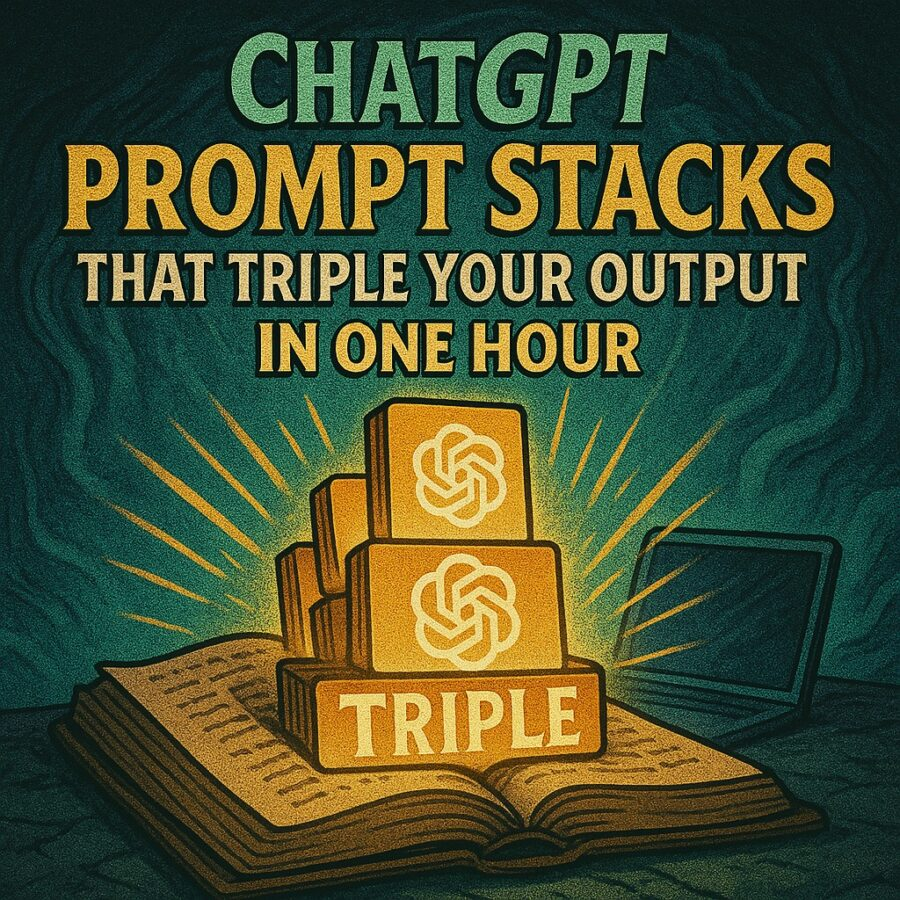Views: 0
Set a timer for sixty minutes. Close the extra tabs. Keep your coffee, lose the chaos. You are about to run a compact system that turns scattered ideas into finished work using ChatGPT prompt stacks. No fluff. No magic tricks. Just a repeatable chain of small, well-aimed prompts that compound.
I call these ChatGPT Prompt Stacks That Triple Your Output In One Hour because each layer handles one job, then hands the baton to the next. The result feels like a tiny production line you can run from your laptop. Prompt stacking is not a slogan. It is a method with roots in known techniques like prompt chaining, ReAct reasoning, and Tree-of-Thoughts style exploration. These approaches have formal write-ups and measurable benefits, which we will tap as we build your stack. (Prompting Guide)
Productivity studies do not promise a miracle, yet the signal is strong. Controlled experiments show AI assistance can raise throughput for real jobs. A large field study of customer support agents measured about a 14 percent productivity gain with generative AI in daily work. Experiments with consultants found faster completion and higher quality for creative tasks. Developer trials with AI pair programming saw a marked speed-up. You will not bank these gains unless you work in a structured way, which is exactly what prompt stacks enforce. (NBER)
To go deeper on AI prompts and real workflows, browse the living library at Alt+Penguin Posts and grab free resources on the Downloads page. You can also pick up ready-made prompt kits in the Shop. For reliability folks, there is a detailed piece on proactive maintenance workflows here: ChatGPT Prompts That Predict and Prevent System Failures.
What “ChatGPT Prompt Stacks” Are and Why They Work
A prompt stack is a short sequence where each prompt completes a single step, then passes its output to the next step. It is the same idea researchers and practitioners call prompt chaining. Stack prompts split a complex task into smaller, visible phases. That reduces cognitive load, improves factual control, and makes it easy to debug. This is how you trade a one-shot monologue for a flexible pipeline. (Prompting Guide)
Two powerful variants sharpen your stack:
- ReAct combining reasoning with actions like searching or tool use. The model reasons, acts, observes, and reasons again. It is ideal when you must check facts or pull outside data during the stack. (research.google)
- Tree of Thoughts exploring multiple options in parallel, then selecting the best branch. Use it when you want creative breadth before you converge. (arXiv)
The “stack” label is also popular among builders in the wild. You may see creator articles that frame it like function chaining for AI conversations. The names vary. The core idea is the same. Split. Sequence. Pass the baton. (AWS in Plain English)
The 60-Minute Blueprint: ChatGPT Prompt Stacks That Triple Your Output In One Hour
Here is the exact agenda. Follow it once to feel the rhythm, then adapt.
Minute 0 to 5: Define the target and constraints
Describe the deliverable, the audience, the length, and the guardrails. Note any sources.
Minute 6 to 15: Build the skeleton
Use ChatGPT to outline sections or steps. Keep it tight.
Minute 16 to 35: Fill sections in parallel
Run sub-prompts per section. That concurrency multiplies output.
Minute 36 to 45: Fact check and tighten
Trigger a ReAct loop for claims that need verification. Then run a Quality pass.
Minute 46 to 55: Format and SEO polish
Convert to your publishing format with headings, slugs, excerpts, and internal links.
Minute 56 to 60: Repurpose
Spin a summary, a short email, and two social captions from the final draft.
The reason this stacks so well is that each slice is fast and visible. If one slice fails, you edit that slice without junking the whole.
Affiliate Link
See our Affiliate Disclosure page for more details on what affiliate links do for our website.
The Seven-Layer Stack You Can Reuse All Week
Use these layers as defaults for writing, research, coding, or planning. Where you see brackets, drop in your specifics.
Layer 1. Role and Objective
Prompt: You are my [role], producing a [deliverable] for [audience]. The goal is [outcome]. Ask any clarifying questions in one list.
Layer 2. Source Sweep or Requirement Intake
Prompt: Given this topic [paste notes or links], list the five most important subtopics and the three claims that need citations. Return as a table with columns: Subtopic, Key points, Possible sources.
Layer 3. Outline with Dependencies
Prompt: Draft a clean outline with section headings. Each heading should state its job using a verb phrase, for example “Define the problem” or “Demonstrate the method.” Add one sentence under each heading that names inputs required from the previous section.
Layer 4. Section Drafts
Prompt: Draft Section [X] from the outline. Use short paragraphs and crisp sentences. Do not exceed [N] words. Flag any missing data as [MISSING: item].
Layer 5. Fact Check and ReAct Loop
Prompt: For the text below, identify every claim that should be checked, propose the quickest way to verify it, and mark anything that looks like speculation. Then produce a corrected version. Cite sources inline with bracketed notes for me to replace with links later.
Layer 6. Edit for Voice, Clarity, and Flow
Prompt: Rewrite the passage for an educated, friendly professor tone. Keep verbs strong. Replace abstractions with concrete examples. Reduce filler. Return a version and a one-line rationale for each change.
Layer 7. Format and Repurpose
Prompt: Convert the final into publish-ready HTML with h2 and h3. Insert three internal backlinks: Alt+Penguin Posts, Downloads, and Shop. Then produce: 1 excerpt under 25 words, 1 meta description under 155 characters, and 2 social captions with hashtags.
Starter Stack: Write a 1,200-Word Article in 60 Minutes
Copy these exactly, then paste your details.
1) Briefing
Prompt: You are my senior editor. I need a 1,200 word article about [topic] for [audience]. Goal is [outcome]. Constraints are [tone, reading level, banned words, formatting rules]. Ask three clarifying questions. Suggest five working titles.
2) Outline
Prompt: Using our answers, create a 7-section outline. Each section should have a purpose line that explains its job in one sentence.
3) Source Map
Prompt: For each section, list two credible sources to consult. Mark sections that require live data checks.
4) Draft in Slices
Prompt: Draft Section 1 in 170 words. Keep sentences short. Use plain language. Do not repeat ideas. End with a handoff sentence that sets up Section 2.
Repeat for sections 2 through 7 with similar prompts.
5) ReAct Fact Check
Prompt: Review the full draft. Identify claims that need verification. For each claim, propose an action such as “search term”, “stat lookup”, “definition check.” Insert bracketed TODO tags like [VERIFY: claim] at the right points. Then present a clean version.
6) Edit Pass
Prompt: Rewrite for rhythm and clarity. Remove throat clearing. Replace vague verbs. Keep the voice consistent. Provide diffs in a simple before and after table.
7) Format, SEO, and Backlinks
Prompt: Convert to HTML with h2 and h3. Include a contextual link to this reliability article from Alt+Penguin if relevant: https://altpenguin.com/posts/chatgpt-prompts-that-predict-and-prevent-system-failures. Add two more internal links to https://altpenguin.com/posts and https://altpenguin.com/downloads. Create a meta description under 155 characters. Create an excerpt under 25 words.
Affiliate Link
See our Affiliate Disclosure page for more details on what affiliate links do for our website.

Starter Stack: Research Sprint With Checks
1) Frame the Question
Prompt: Act as a research librarian. Clarify the scope of [topic]. List five sub-questions that a careful analyst would ask.
2) Gather Facts
Prompt: For each sub-question, propose three search queries and the likely source types that would answer them.
3) ReAct Lookups
Prompt: Execute a reasoning plan. For each sub-question, produce a claim, a supporting quote or statistic, and a citation note. Call out any uncertainty.
4) Resolve Conflicts
Prompt: Where two sources disagree, summarize the disagreement and suggest how a responsible writer should present it.
5) Produce the Brief
Prompt: Build a one-page brief with a TLDR, a key statistic list, a risks section, and 3 charts to sketch.
Use ReAct concepts to design the “reason, act, observe, reason” loop that catches mistakes. That habit raises quality and speed together. (research.google)
Starter Stack: Freelancer or Small Business Sprint
1) Offer Clarifier
Prompt: You are my product marketer. Turn this rough offer [paste] into a clear value statement, ideal customer profile, and two buyer outcomes.
2) Objection Bank
Prompt: List the top ten objections based on the offer and audience. Map each to one counter-message and one proof point.
3) Landing Copy
Prompt: Draft a landing section with headline, subhead, value bullets, and call to action. Keep jargon out. Aim for clarity.
4) Email Pair
Prompt: Write two short emails. First is a problem opener. Second is a proof note with one case example. Keep each under 120 words.
5) Pricing Table
Prompt: Generate a three-tier pricing table with feature rows. Add a one sentence nudge for each tier.
6) Repurpose
Prompt: Turn the landing copy into two social posts and one short script for a 30 second video.
Then link to assets and articles on your site to keep visitors in your world. Start with Alt+Penguin Posts, Downloads, and the Shop if you mention prompt kits.
The Dependency Grammar Trick That Keeps Stacks Coherent
Think like a developer wiring functions. Each prompt’s output must satisfy the next prompt’s input. The clean way to do that is to label each section with its job and its dependencies.
Try this micro-framework inside your prompts:
Head state the role and goal.
Args list the inputs expected from the previous step.
Constraints style, tone, length, rules.
Test how success will be recognized in the next step.
Example:
Prompt: You are my outline strategist. Args: topic, audience, goal. Constraints: 7 sections, action verbs in headings, one sentence per section describing its job. Test: The next step should be able to draft any section without asking me what it is for.
When each layer declares its Args and Test, your stack stops wobbling. Outputs become plug-compatible. You spend less time fixing mismatches and more time shipping.
Quality Guardrails That Make “Triple” Realistic
You are trying to triple throughput, not triple errors. These guardrails keep stacks lean and credible.
1) Check high-impact claims
Run a fast ReAct pass and tag anything that needs a source. This yields clarity with a tiny cost. (research.google)
2) Use deliberate exploration when creative stakes are high
If you need a concept list, have the model branch on three options and score them against explicit criteria. That is the Tree-of-Thoughts spirit, in miniature. (arXiv)
3) Borrow evidence from credible studies
When you justify process changes or tool adoption, ground the case in published work. For example, the call-center study measuring a 14 percent average productivity gain, the BCG experiments that saw faster completion and higher quality on creative tasks, and the GitHub trials that reported about a 55 percent speed-up. These are not guarantees for your context, yet they are helpful anchors. (NBER)
4) Keep slices short and observable
A prompt that tries to do everything hides mistakes. A smaller prompt shows its work. If something breaks, you can repair that piece without burning time on the rest.
5) Use time boxes
Work in ten-minute windows for creative tasks and five-minute windows for edits. Speed focuses attention and makes each slice feel like a game level.
Affiliate Link
See our Affiliate Disclosure page for more details on what affiliate links do for our website.
Five Ready-to-Run Prompt Stacks
A) One-Hour Blog Workflow
Prompt: Draft five working titles on [topic] for [audience]. Score each on curiosity and clarity.
Prompt: Build a 7-section outline with one sentence of purpose under each heading.
Prompt: Draft Section 1 in 150 to 180 words. End with a one sentence handoff to Section 2.
Prompt: Draft Section 2 using the handoff. Keep new ideas only.
Prompt: Repeat for all sections.
Prompt: Run a ReAct pass to flag claims that require citations and propose verification steps.
Prompt: Edit for rhythm. Replace weak verbs. Shorten long sentences.
Prompt: Convert to HTML with h2 and h3. Insert contextual internal links to https://altpenguin.com/posts and https://altpenguin.com/downloads. Generate an excerpt and a meta description.
B) Ten-Slide Deck in 30 Minutes
Prompt: Create a 10 slide outline for a talk on [topic] to [audience].
Prompt: For each slide, write a heading, three bullet points, and a simple chart suggestion.
Prompt: Write a one-paragraph speaker note per slide.
Prompt: Produce a final slide list as JSON for quick import.
C) Sales Email and One-Pager
Prompt: Turn this offer [paste] into a one sentence value prop and three proof points.
Prompt: Draft a two-email set. First email is a problem opener. Second email is social proof with one brief example.
Prompt: Convert the offer into a one-page brief with headline, subhead, three value bullets, and call to action.
Prompt: Add two internal links to https://altpenguin.com/shop for prompt kits and https://altpenguin.com/posts for learning resources.
D) Technical SOP Snap-to-Grid
Prompt: List the five critical steps to perform [procedure].
Prompt: For each step, produce purpose, inputs, actions, outputs, and common pitfalls.
Prompt: Convert the result into a numbered SOP with checkboxes and a log table.
E) Creative Options, Then Converge
Prompt: Generate three distinct concepts for [asset]. For each, provide a title, a 2 sentence pitch, and one visual example.
Prompt: Choose one concept using criteria [audience fit, novelty, ease]. Explain the decision in one paragraph.
Prompt: Draft the asset with the chosen concept.
This follows a trimmed Tree-of-Thoughts cycle explore, judge, commit. (arXiv)
Common Failure Modes and Quick Fixes
Stack gets repetitive.
Insert a constraint like “only include new ideas” and require a handoff sentence between sections.
Model invents facts.
Add a ReAct step for verification and specify what counts as a source. Treat any [MISSING] tag as a blocker before publishing. (research.google)
Tone keeps drifting.
Run a style lock prompt mid-stack. Paste a short voice sample and ask for a style sheet with rules. Apply it in later steps.
Outline bloats and time slips.
Impose word caps per section. Set a five-minute cap per slice. Use a final formatting prompt that trims without mercy.
You forget to add internal links.
Bake them into your final formatting prompt. Add a checklist at the end with links to Alt+Penguin Posts, Downloads, and the Shop.
When to Use More Advanced Reasoning
Two signals tell you to add heavier reasoning tools:
1) You need outside data or actions mid-stack
Use a ReAct prompt. Example instruction inside your stack: “If a claim requires verification, perform a search step, read the top result, then update the draft with a citation note.” This interleaving reduces wrong turns. (research.google)
2) You need breadth before depth
Use a mini Tree-of-Thoughts fork. Ask for three short alternatives, each scored against your criteria, and then select. It feels like having three colleagues brainstorm while the clock runs. (arXiv)
Both patterns have peer-reviewed write-ups and public demos. The point is not to cosplay as a researcher. It is to steal the parts that help you ship.
Affiliate Link
See our Affiliate Disclosure page for more details on what affiliate links do for our website.

Proof That Stacks Beat Freestyle
Working in slices is not just an aesthetic preference. It helps you do more high value work per hour. Here is the practical logic.
Short prompts compile faster
You can see errors early. You can course-correct without throwing away a long output.
Dependencies prevent drift
Each section states what it expects and what it will deliver. That keeps the chain tight.
Reason-act loops reduce rework
You catch weak claims before they spread across the piece. It is cheaper to fix one sentence than a whole draft. The formal literature on ReAct explains why this works. (research.google)
Parallelism multiplies throughput
Once the outline is set, you can draft non-adjacent sections in parallel, then stitch. That is how you reach the “triple” range on good days.
For a deeper tactical example of predictive maintenance prompts linked to action, study this internal piece: ChatGPT Prompts That Predict and Prevent System Failures. It shows how to move from observations to interventions with minimal waste.
Your 10-Minute Daily Drill
Run this quick stack at the start of the workday to set the table.
Prompt: List the top three tasks that would move the needle for [project].
Prompt: Break Task 1 into four micro-steps with an estimate for each.
Prompt: Write the first email or draft needed to start Task 1.
Prompt: Create a two line update I can paste to my team chat after completing Task 1.
Prompt: Suggest one way to reuse today’s work inside a larger asset.
If you only adopt one habit from this article, make it this drill. Ten minutes, real momentum.
Evidence Sidebar for Skeptics
Skeptical minds are welcome here. A few anchors:
• Customer support field study measured about a 14 percent productivity lift when agents used a generative assistant. Effects were larger for less experienced workers. That is realistic and valuable. (NBER)
• Consultant experiments showed faster completion and higher quality on creative tasks when using GPT-4, with cautions on analytical tasks without checks. A good reminder to pair speed with verification. (BCG)
• Developer experiments saw roughly a 55 percent speed-up on a coding task when using an AI pair programmer. The principle transfers to content and research when you modularize. (The GitHub Blog)
None of these studies promise that you specifically will triple output. They do show that structured AI assistance moves the needle in consistent, measurable ways. A prompt stack is how you harness that upside without gambling your quality.
Bring It Home: Your One-Page Stack Template
Copy this into a doc and use it as your daily control panel.
Prompt: You are my [role]. Goal: [deliverable for audience]. Constraints: [length, tone, style]. Ask three clarifying questions.
Prompt: Build a 7-part outline. One sentence of purpose under each heading.
Prompt: List two sources or checks required per section.
Prompt: Draft Section 1 in [N] words. End with a handoff sentence to Section 2.
Prompt: Draft Section 2. Keep only new ideas.
Prompt: Repeat for Sections 3 to 7.
Prompt: Run a ReAct fact-check pass. Tag claims with [VERIFY] and propose verification actions.
Prompt: Edit for clarity. Use concrete nouns and strong verbs.
Prompt: Format with h2 and h3. Insert internal links to https://altpenguin.com/posts, https://altpenguin.com/downloads, and https://altpenguin.com/shop. Produce an excerpt under 25 words and a meta description under 155 characters.
Prompt: Repurpose into a 3 sentence summary, a short email, and two social captions.
If you prefer a ready kit instead of wiring by hand, you can browse prompt packs in the Shop and pull templates from the Downloads page.
Final Nudge
Your brain loves to hoard half-finished work. A prompt stack fights that tendency with small gates and fast feedback. It turns chaos into a clean assembly line. It respects reality that facts must be checked and formats must be clean. It borrows from research without getting academic about it. Most of all, it is fun. Open a fresh chat, pick one of the stacks above, and run the first prompt. Sixty minutes from now you will have something real to ship.
If you want to browse more stacks, case studies, and prompt patterns, start at Alt+Penguin Posts and keep a copy of the reliability workflow here: ChatGPT Prompts That Predict and Prevent System Failures. Then grab a freebie or two from Downloads and keep a toolkit ready in the Shop.




